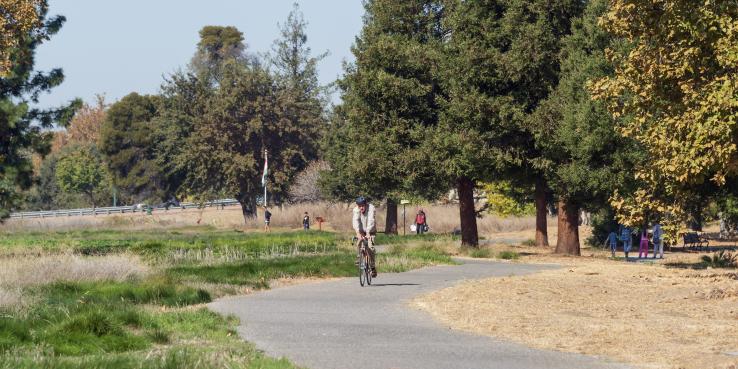When it opened in 2005, Guadalupe River Park and Gardens was ground-breaking in its flood protection infrastructure and public space design. But the park has aged, making a number of challenges clear. Maintenance funding cuts and a lack of amenities and design features have left the park underutilized.
In January 2022, SPUR launched Re-Envisioning the Guadalupe River Park, an online exhibition gathering research and recommendations that highlight this problem but also the park’s potential to advance San José’s economic development, public open space, and ecological restoration goals. The exhibition presents recommendations from SPUR reports such as Re-Envisioning the Guadalupe River Park, Homelessness and Public Space Toolkit, Rewilding the Guadalupe River in San José, and The Economic Impact of the Guadalupe River Park. Taken together, these reports envision Guadalupe River Park and Gardens as a flourishing natural habitat, a hub for community engagement, a catalyst for economic and cultural vitality, and an inclusive gathering place for residents, workers, and visitors.
Hundreds of the visitors to the exhibition have responded to questions we posed about barriers to and opportunities for the river park’s continued development and enhancement and about park funding and stewardship. Their responses, along with the research captured in the exhibition, can inform San José’s plans for a denser, more connected downtown in which the city’s grand park is the focal point of community-building and economic development priorities.
The Vision: Building Equity and Uplifting Communities
A recurring theme in exhibition visitors’ responses to our questions was the desire to connect the natural ecosystem and open spaces of the park with the downtown built environment. The park's primary constituents are residents of the surrounding neighborhoods, and these neighborhoods reflect San José's demographic and socioeconomic diversity. Our report A Shared Future in Downtown San José found that this diversity and the fast-paced urban transformations around Guadalupe River Park present park managers with opportunities to better integrate the park in plans for the downtown’s growth.
Connection to nature is the greatest opportunity. I live nearby and the downtown urban area is getting to be an asphalt jungle, streets entrapped by a tangle of freeways. For me, it is being near nature that makes the park the most valuable.
— Exhibition visitor
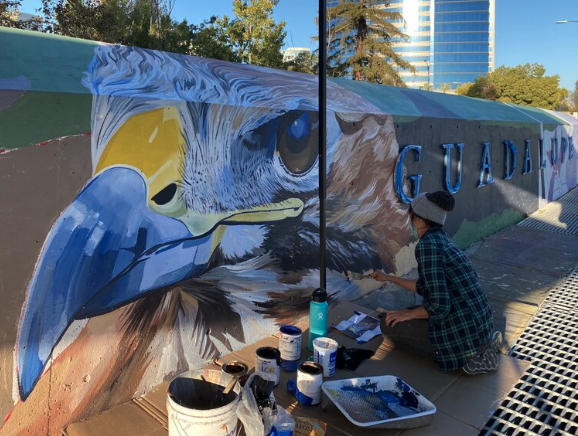
Another recurring theme in exhibition visitors’ responses was the high value they attach to programs provided by the Guadalupe River Park Conservancy and other organizations. The conservancy maintains a schedule of events such as Pumpkins at the Park, trail cleanups, and educational programs for adults and children. This year, the conservancy built on a partnership with San Jose Walls to create 10 new art and mural installations at 5 sites along the Guadalupe River Trail.
Our research finds that park stakeholders should leverage current partnerships and continue to build new ones to further provide programs that celebrate diverse cultures, include different communities in the life of the park, and create opportunities for people, small businesses, and communities to grow and thrive. It further finds that the City of San José and advocacy partners should develop and pursue policies and development — such as affordable housing, workforce training, and community facilities — that ensure an inclusive environment in and around the park.
The Strategies: Expanding Park Access and Improving the Park Experience
Redevelopment investment that’s intended to reshape the downtown area presents an invaluable opportunity to make the city’s largest urban park a driver of engaged, equitable, and sustainable communities.
[The park] needs to be all the things: a river area for wildlife, a trail for commuting/being outdoors, and a public gathering space. There is so much space along the river park (and in parking lots adjacent to it) for food trucks or permanent market stalls like Pike Place. That area has the capability to be a beautiful attraction, and I'd love to be able to buy a coffee, sit at a table, and look down the river. I would be there every day!
— Exhibition visitor
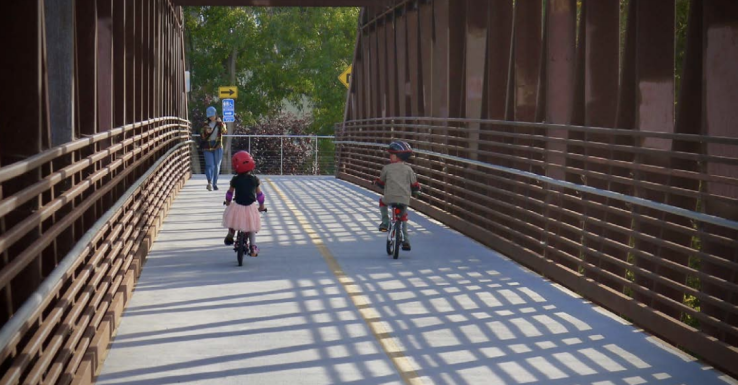
Our report A Shared Future in Downtown San José outlines eight strategies to expand park access and improve the park experience for the diverse communities in and around downtown San José. These strategies reflect key lessons from across the country:
- Implement proactive measures to prevent displacement and gentrification and to increase community support for park revitalization.
- Directly engage underhoused populations to set the tone for coexistence and create inclusive opportunities for park revitalization programs.
- Develop park design through robust community engagement in order to thoughtfully address how communities access the park.
- Incorporate thoughtful design features within the park that support local art and cultural initiatives and create spaces for diverse communities to gather, build social cohesion, and assemble peacefully.
- Regularly schedule programming and special events to increase visitorship, bring different communities together, and foster diversity, equity, and inclusion.
- Ensure that park planning and development equitably incorporate small businesses and help community entrepreneurs thrive.
- Develop park-based youth employment and education opportunities, particularly green initiatives, to enhance community cohesion and inclusion.
- Expand volunteerism and equitable donation systems to give communities a sense of ownership and help park managers meet operational goals.
These strategies can positively reshape the spatial dynamic between community and ecology as well as center equity and inclusion in the park’s revitalization.
Yet another strategy, already implemented by San José, illustrates how that revitalization can promote employment. In 2021, the Guadalupe River Park Conservancy partnered with the city’s newly created Resilience Corps, a jobs program supporting underemployed young adults through living-wage employment and work experience opportunities, to maintain the river park. San José is not alone in using river park maintenance to develop employment and education opportunities. Cities across the country have developed and funded work programs for the unhoused or unemployed to maintain their river parks, giving communities a sense of park ownership and park managers the ability to meet operational goals. Some cities also use their river parks to provide volunteer opportunities by enrolling volunteer stewards to lead outdoor educational walks and organize other park-associated activities.
The Needs: Stewarding and Funding the Park
A revitalized urban park can spur positive changes across the city and support equitable outcomes and economic benefits for many. What has become clear through our research and visioning for Guadalupe River Park is that realizing these changes and outcomes will require a cohesive strategy for park governance and stewardship by organizations, government, and community stakeholders.
SPUR recommends that the park’s governance and stewardship strategy focus on coordination, integration, equity, and funding. All parties involved in the revitalization and well-being of both the park and the greater downtown should:
- Remain aligned in their mission, increase their service capacities as quickly as possible, and pool their resources to provide quality maintenance, operations, and management.
- Integrate the park into downtown San José’s economic, social, and cultural ecosystems to enliven the park and advance the shared goals of public interest, private interest, and community stakeholders.
- Continue to expand equitable access to public spaces and programming in the park and plan for growth in the neighborhoods surrounding the park, creating park-adjacent educational, health, and other community facilities where all people can connect and share the fruits of San José's progress.
- Secure diversified funding sources to sustain the park and other community infrastructure in the surrounding area as well as study short-term and long-term strategies to increase public and private sources of revenue.
Funding for park maintenance is probably primary. Without a commitment that the Guadalupe is as essential to SJ as Golden Gate Park to SF, or San Antonio's Riverwalk, it will never be a focal point, and won't attract sufficient budget. It also needs retail engagement – restaurants, bike rentals, restrooms, b[asket]-ball courts, etc... to drive traffic to it.
— Exhibition visitor
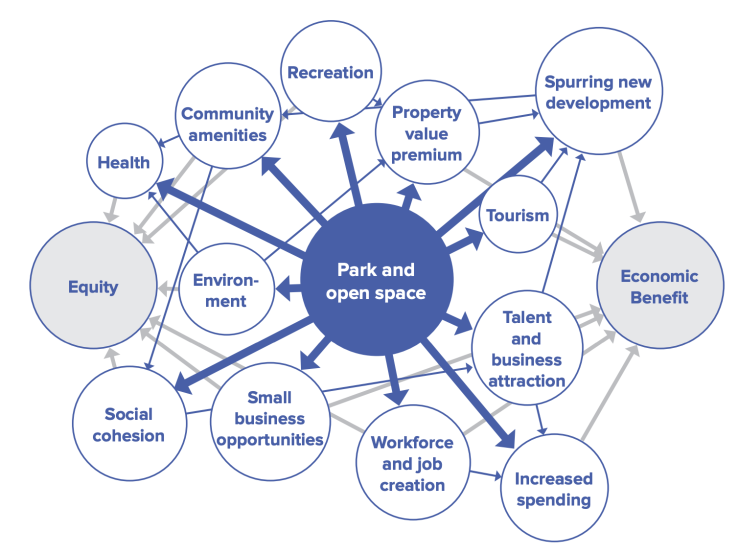
Click image to zoom.
The Opportunity: Collaborating on a Shared Vision
Successful urban parks rely on productive and collaborative relationships among public, private, and community partners as they assess possible near-term and long-term arrangements for the governance of the park in order to ensure a viable framework for coordination. In 2023, the City of San José’s Department of Parks, Recreation, and Neighborhood Services and the Guadalupe River Park Conservancy will embark on a revised management agreement to guide governance and stewardship of the park. This agreement will create a critical opportunity to reflect on best practices and on relevant experiences from across the country. Ultimately, it will unlock value for San Jose’s downtown and explore diversified funding sources for the park.
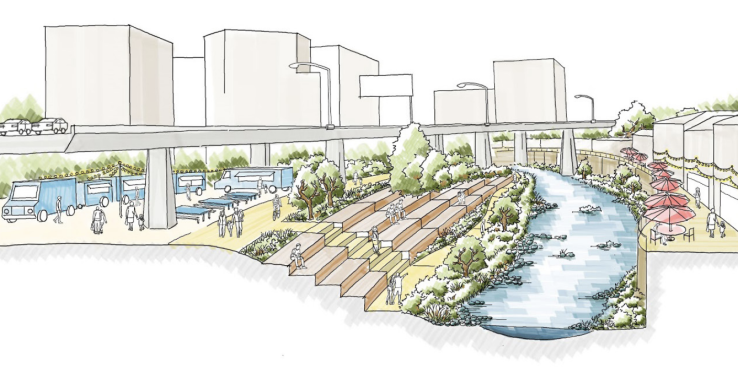
Many factors point to the present as a critical time to begin creating the park’s future. Downtown San José and its surrounding neighborhoods make up the most urban place in the South Bay; between 2000 and 2010, the area became home to more than 300 restaurants, bars, and entertainment venues and 8,000 new residents. Planned investments will make downtown San José one of the most transit-connected locations in the state. San José State University, the Convention Center, four theaters, the SAP Center (home of the San José Sharks hockey team), and 38 cultural and civic institutions, along with major festivals and events, make its streets increasingly lively.
A sustainable and successful stewardship model for the river park could provide economic development, physical and mental health, social cohesion, fiscal revenue, ecological diversity, and environmental sustainability co-benefits. The time is ripe for San José to realize the vision for its grand park. We look forward to continuing the strong partnerships, collaborations, and advocacy that will guide this vision for Guadalupe River Park and Gardens.
SPUR's multi-year Guadalupe River Park initiative is made possible with generous support from the John S. and James L. Knight Foundation and has been pursued in collaboration with the Guadalupe River Park Conservancy, Valley Water, and the City of San José’s Department of Parks, Recreation, and Neighborhood Services.
